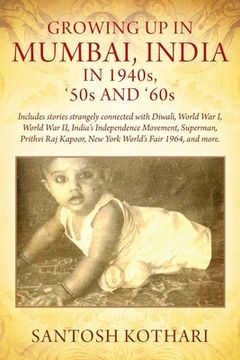GROWING UP IN MUMBAI, INDIA IN 1940s, '50s AND '60s: Includes stories strangely connected with Diwali, World War I, World War II, India's Independence (en Inglés)
Reseña del libro "GROWING UP IN MUMBAI, INDIA IN 1940s, '50s AND '60s: Includes stories strangely connected with Diwali, World War I, World War II, India's Independence (en Inglés)"
Author Santosh Kothari, age 78, a successful professional structural consulting engineer and a successful real estate developer and investor, looks back at the time of his childhood in Mumbai (Bombay), India. The period of this book is 1942-1964. This period begins during world war II and India's independence from 200 years of British Colonial rule and ends with his arrival in United States.It was a unique period of transition from old to new. There was very little personal transportation-cars, motorbikes, and scooters were rarely used by anyone except the very rich. Even ownership of bikes was not that common. Electricity was available only in big cities and only in prosperous areas. Personal visits were the popular method of conducting relations and business. The postal service and telegraphs were the popular methods of communication. Phones were very scarce and unaffordable. Most people lived in combined families where two to three generations lived together. Everything was shared. This period was a simpler, more peaceful, more leisurely, and less stressful time. The Indian population was about a quarter of today's population. There was lot more greenery in cities; a lot more open space; a lot less crowding; a lot less competition; and a lot less greed. That time is gone, forever. Take a trip thru this unique period with the author to discover a different world and to reminisce about your own childhood. The cover with various shades of yellow and baby picture of author evokes innocence, optimism and curiosity of a child. The brown and gray antique look brings back memory of an era long gone. You will find unexpected information throughout. For example, in: -Chapters 2, 11 and 21, experience traveling in Indian trains.-Chapter 3, learn something new about World War I, World War II and Indian Independence struggle.-Chapter 4, enjoy Diwali, the biggest holiday in India.-Chapters 6 and 12, read about my village, role of animals in village, and delicious Indian Fruits. -Chapters 7, 8, 9 and 18, get a glimpse of life in Mumbai Chawls which is similar to life of millions around the world.-Chapter 10, read about uniquely Indian games and sports.-Chapter 13, read and almost taste Indian Marwari regional food from Madhya Pradesh and Rajasthan.-Chapters 14 and 15, romance and Bollywood are inseparable in India.-Chapter 19, a personal tragic accident resulted from unsafe conditions that attract very little attention in India.-Chapter 22, describes Indian caste system and how India has handled discrimination.-Chapter 26, join the author on a trip of twelve locations in North part of India on a seventeen days trip covering four thousand miles by Indian trains and read a short history of India connected to these places.-Chapter 27, read how author got a great Icon of Indian Film Industry, Prithvi Raj Kapoor, to make an appearance at a fund-raising event organized by author at his college, at no cost, at age 19.-Chapters 30, 31 and 32, read about author's arranged marriage, still strong after 56 years. Hindu marriage rituals are explained. These rituals may hold the secret of why very few Indian marriages result in divorce.-Chapter 34 is a "Must Read" for anyone who is curious why superman and Loise Lane are in title.

